
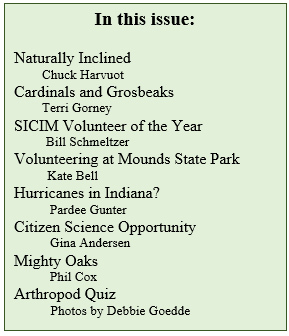 |
|
In May, along with several other IMNs, I attended a Nature of Teaching workshop offered by Purdue Extension at the PFW campus in Fort Wayne. The concept of the program is to provide resources and the necessary tools to get youth outside and engaged with nature. The program includes both formal and informal standards-based curricula on more than 50 tested lesson plans. All Nature of Teaching lesson plans are free, downloadable via purdue.edu/nature, and target STEAM standards for K-12 students. For IMNs, there are lots of good ideas to include in an existing Jr. IMN or Teen IMN program, or to provide a foundation to start a program. |
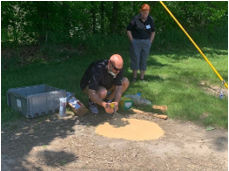
The Nature of Teaching has three program areas of the formal curricula: Wildlife, Health and Wellness, and Food Waste. With so many varied lesson plans, we were only able to “get a taste” of a few. After an overview of the program, we went outside and learned to make a “scent station”, using play sand, a narrow board about 30” long, a sifter and a spray bottle. After the station is finished, scent, or bait, is placed in the middle. Vanilla extract can be used as bait, as well as rabbit or deer urine. Our instructor told us he had a large bottle of rabbit urine he used and would be willing to share if any of us wanted some. I quickly raised my hand, as did most of the others. (I mean, what Master Naturalist doesn’t want a supply of rabbit urine on hand?) The station would then be checked for several days to see what animals would have left footprints in the sand as they came to investigate the smell.
|
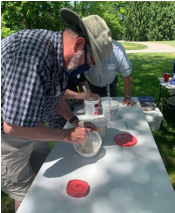
After completing our scent station, we all made an animal track mold, using Plaster of Paris and rubber replicas of animal tracks. I had helped students with this type of activity before; it’s not as messy as one might imagine. And, I know how much kids like doing it, and the mold they get to take home. (Please note that Purdue Extension does not provide the molds; you, or your organization, would need to purchase them—there are a variety of sets available online.) My Grey Fox mold came out pretty well.
|

Back inside we used a stacking wooden block game (like Jenga) to play an Eco-llapse game, intended to teach how outside factors can affect the ecosystem. Different colored blocks represented Producers, Primary Consumers and Secondary Consumers and were added or removed depending on the spin by each player. Jody Heaston and Russ Voorhees proved to be tough competition. I caused the Ecosystem (stack of blocks) to collapse when removing a Producer.
We continued with a Guided Imagery session designed to have students think about how different environments can affect one’s well-being and a second activity with flash cards intended to improve communication skills using descriptive words. We were sent back outside to test our sense of smell, hearing, and sight—we each had to choose a spot and then write a description focused on each of the three senses. This is an activity that could be repeated on different days to see if changes occurred in what each student smelled, heard, or saw.
Next, we were given a Scavenger Hunt worksheet and sent outside to “hike” around the PFW Environmental Resources Center to check off different components of wildlife habitat. Even though it was a simple worksheet, I couldn’t find a mushroom or pinecone before having to return inside. Unfortunately, we did not have enough time to review the lesson on Food Waste and Environment during the workshop. However, I have been able to read through the lesson plan printout included in the folder, and there are some good ideas in it.
At the time of this writing, there are still four workshops scheduled, one in June and three in July. If any of what I have written about sounds of interest to you, I recommend attending one of the remaining workshops. If you are not able to do so, please check out the Nature of Teaching website, at purdue.edu/nature. It is filled with ideas and materials that can be downloaded and then printed. Each lesson plan has a description, a sneak peek video, a download, and an assessment section.
While I can’t promise you’ll get a small supply of rabbit urine, you will get four Education hours and a number of good ideas to use.
Your IMN Council President,
|

The Cardinals and Grosbeaks of Limberlost
by Terri Gorney, AIMN 2014 Fort Harrison State Park
Gene Stratton-Porter set her first novel “Song of the Cardinal” at Rainbow Bottom, which is by the Ceylon Covered Bridge (the last covered bridge on the Wabash River) in Geneva. In Gene Stratton-Porter’s time, cardinals were just starting to migrate north into the area from southern states and were not as common as they are today. Gene called them cardinal grosbeaks.
There are two other closely related birds to the northern cardinal; they are the rose-breasted grosbeak and the blue grosbeak. The rose-breasted grosbeak is a summer migrant to the Limberlost area that likes nesting in shrubby areas. In the past few years, blue grosbeak pairs have been seen at the Loblolly Marsh Nature Preserve during the warmer months.
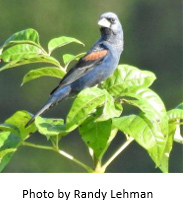
On July 25, 2020, Randy Lehman and I were walking west of the Ceylon Covered Bridge, and Randy took a picture of a male blue grosbeak in a short tree. This is the first one seen in this recently restored area called Fields Park along the Wabash River. Today it is a scrubby area with small trees, which is perfect habitat for the bird.
A week later, on Aug. 1, we walked Rainbow Bend, and spotted a juvenile blue grosbeak singing from a tree. He dropped to the ground and was foraging, then flew to the top of another tree that was planted about eight years ago. This is the first known blue grosbeak in this area, and a juvenile, which meant a pair was successful nesting in this area. Randy was able to document this bird with photos, and my brother, Don Gorney, was able to positively ID it. It is probable that he was not far from the nest in which the bird hatched. The Friends of the Limberlost own the 231 acres at Rainbow Bend-Bottom along the Wabash River. It is exciting to know that restoration of parts of the old Limberlost Swamp is having the desired effect for bird habitat.
Today, Geneva’s mascot is the cardinal. It is even painted on the water tower. I think Gene would be pleased that 118 years after she wrote “Song of the Cardinal” that there are now a good number of cardinals that are year-round residents and rose-breasted grosbeaks and blue grosbeaks that spend the summer at Gene’s beloved Limberlost. To learn more about the Limberlost area visit https://limberlost.weebly.com/
|
IMN Bill Schmeltzer Named Volunteer of the Year
During the Zoom virtual annual meeting of the Southern Indiana Cooperative Invasives Management (SICIM), Advanced IMN (2015 Bloomington), Bill Schmeltzer was surprised to hear he had been selected as Volunteer of the Year.
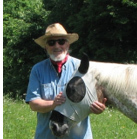
Serving on the Communications Committee of SICIM, Bill has put to use his IMN training when new publications about invasives are reviewed before release and in reviewing website and social media content and traffic. “It is important that accurate and reliable information about the negative impact of invasives is available to the public,” said Bill. Additionally, Bill has been writing articles for the SICIM quarterly newsletter and shooting informational videos. “Many years ago I was shooting film, which evolved to VHS-C, and now it’s digital; each format had challenges in getting good results,” added Bill.
In recent years SICIM has expanded its education efforts across Indiana through the Indiana Invasives Initiative (III). The III has established regions in Indiana where specialists in invasives have established local CISMAs (Cooperative Invasive Species Management Areas). “The invasives problems in Indiana have varying impacts depending on location. Johnson grass may be a major problem in one area while Autumn Olive may have a major impact just two counties over,” said Bill. By volunteering as an AIMN at the State Fair, Bill has been able to tell people from all over Indiana about the recreational opportunities at DNR parks while hearing about their nature concerns.
IMN training has helped Bill keep his family’s rural property in Lawrence County safe for their horses and keep their woodlands growing healthy. “Working with nature by having native plants, controlling dangerous species, and understanding your property’s relationship to the total landscape is important,” said Bill.
Find out more about SICIM at http://www.sicim.info/ and like them on Facebook.
|
My Volunteer Experience at Mounds State Park
by Kate Bell, AIMN
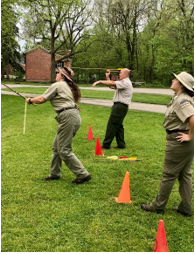
Mounds State Park, located in east-central Indiana, has a wealth of historical significance. In addition to the Bronnenburg Pioneer Home and artifacts from an early 20th century amusement park, the park is home to 10 earthworks built by prehistoric indigenous people known as the Adena and Hopewell. These people resided in and around the property more than 2,100 years ago. In addition to having a replica of a dugout canoe and wigwam, the park has trails that take visitors to some of the earthworks or mounds on the site. The staff offer school field trips, tours and special event presentations to guests visiting the park. One of the many presentation offerings is that of learning to use an atlatl. Atlatl translated means “stick stick” and is a spear throwing system. This technology was used to hunt large game during the pre-Columbian time period. An atlatl is comprised of two components. One component is the caster or spear thrower, and the other is the dart or spear. The use of the caster and dart system creates a lever that greatly increases the velocity and distance of the throw, thus providing the hunter with a greater success rate. These components would have been very important for hunting large game such as bison, elk or bear. To really experience the excitement of the hunt to visitors, Mounds State Park provides its guests with a bison target to aim at while learning this technology.
|

My son, who is now 15, enjoys practicing this technology. Because of his abundant enthusiasm for this activity, while “assisting” the naturalist staff at special events, he rendered their existing target unusable. To make amends, my son purchased new materials, and with my husband’s 150% assistance in the designing, planning, and painting, together they created a new target to be used at these events. We presented the park with this new target at the Volunteer Appreciation event in 2020.
|
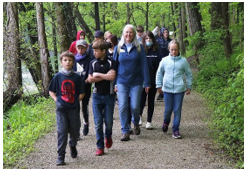
Our entire family enjoys not only spending time in the park but also volunteering. As a family we have been members of the Friends of Mounds group for many years. We also were very lucky to be part of the crew that created the wigwam structure in 2017 and have participated on work days to cut invasive honeysuckle and pull garlic mustard. My husband, Vance, is an art professor at Ball State University and has provided flint knapping workshops (making projectile points from stone tools) and presentations on multiple occasions for the park. My son, Brentten, attended the Teen IMN Camp and received his IMN certification in 2019. I received my initial IMN training in spring of 2014 and took the training again the same summer at Mounds to receive my Advanced IMN certification. I attended Interpretative Training in 2015 and also hope to attend Interpretative Training again in the future to receive my CIG (Certified Interpretive Guide) certification. I have been volunteering at Mounds State Park and Summit Lake State Park since 2014. I am one of several volunteers who help the naturalist staff lead field trips for large school groups and camps. I have done everything from assisting with weekend winter workshops to demonstrating how to make pinch pots and working on Geocaching events. I have presented Dutch oven cooking demonstrations to the Friends of Mounds group as well as during Pioneer Days events.
I still absolutely love this program, and l look forward to every learning event provided! To learn more about Mounds State Park visit https://www.in.gov/dnr/state-parks/parks-lakes/mounds-state-park/
|
Hurricane Watch for Indiana?
by Pardee Gunter, IMN Council Member
Did you know that hurricane season has started? June 1-Nov. 30 is hurricane season. You are probably wondering why I am talking about hurricanes here in Indiana. Unless you are planning a trip to the Gulf Coast this summer, you probably are not thinking too much about them … but … Hoosiers, especially IMNs, should pay attention to hurricanes that make landfall along the Gulf Coast. Not that it is something life-threatening for us, but for IMNs who spend a significant amount of time outside, it can have effects.
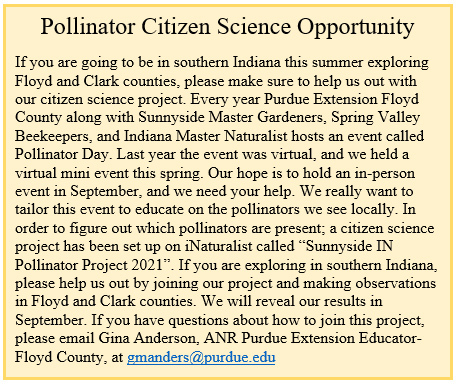
When a hurricane (straight-line winds above 74 mph) makes landfall along the Gulf Coast, it quickly becomes a tropical storm (straight-line winds from 39 mph to 73 mph), then further degrades to a low pressure system called a tropical depression (straight-line winds less than 39 mph). Sometimes these tropical depressions can head up north and affect us with heavy rain and wind. This is not its usual path; however, its usual path starts out northerly and then it often makes a turn before reaching Indiana and heads northeast, but even this has an effect.
Low pressure systems tend to bring rain, and high pressure systems tend to bring fair weather. If a fair weather high pressure system happens to be over Indiana when a hurricane’s low pressure system pushes past Indiana to the south and east, it tends to “stall out” our weather for a few days. We can expect a few more days of calm, fair weather until the former hurricane is out of the picture. The opposite can happen when a low pressure system is near or on top of us when a former hurricane’s low swings through. The result is a stalling out of inclement weather. Sometimes, in a worst case scenario, the two low pressure systems can merge and dump buckets of rain on Indiana.
Fair weather or wet, it is something to think about as we plan our outdoor activities. (Thanks to Maci Tetrick, Meteorologist for Channel 57 News, for checking this article for accuracy).
|
Mighty Oaks from Little Acorns Grow
by Phil Cox, IMN Council Member
As I write this, spring is all but gone—along with native redbuds, dogwoods, crabapples, and other conspicuous flowering trees that had been showing off their beautiful blossoms in our natural areas and home landscapes. It makes sense that a lot of IMN Workshops have a class with something pertaining to native trees of Indiana, since they are so beautiful and functional. I think that most IMNs have a favorite tree or two and my favorites are the oaks. For me to pick a favorite oak species would be like having to pick a favorite child, as they all have different attributes that I enjoy. The rest of this article will be devoted to particulars about oaks that I hope you will find interesting.
Our native oaks, in the genus Quercus, were also blooming (though not as brilliantly as some previously mentioned species) this spring. Their leaves were also developing at the same time as they were blooming and are about the same color as the flowers, so they are somewhat camouflaged if you don’t look closely. Their flowers are unisexual on the same tree, meaning there are separate male and female flowers at different locations on the tree. The male flowers are long, spindly catkins (2 to 7 inches depending on the species of oak) that contain the pollen and are spectacular in their own right. Whereas the female flowers are much more inconspicuous and harder to find, but of course they have the ovary that is fertilized to produce acorns. To produce viable acorns, female flowers must usually be cross-pollinated with pollen from another oak tree of the same species with help from the wind. Therefore, if you want viable acorns there must be another oak of the same species in at least the vicinity where wind can blow the pollen from one tree to another. Patience is also very important, as it takes at least 17 years for most oaks to start flowering and producing acorns. You may want to consider planting an oak seedling(s) or acorn(s) that will grow up to be “A Mighty Oak” tree in your home landscape. That is, if you have enough room and probably even thinking ahead to if there will be room for the next homeowner. Acorns are great for many local wildlife species; in fact, there are more than 100 species of vertebrate animals that are known to consume acorns in the U.S., including mammals such as white-tailed deer, gray squirrels, fox squirrels, flying squirrels, mice, voles, rabbits, raccoons, opossums, gray foxes, and red foxes. Birds that feed on acorns include wild turkey, bobwhite quail, wood ducks, mallards, woodpeckers, crows, and blue jays.
Not quite as obvious is the importance of oaks to our songbirds. This is because of the value to them via the food chain: producer (leaf) to caterpillar (or other insect stage) to songbird is incredibly important to songbirds and their young that survive on adult insects and their young. In Dr. Douglas Tallamy’s landmark book, Bringing Nature Home: How You Can Sustain Wildlife with Native Plants (2007), he references research that the Quercus genus (from eight mid-Atlantic states) supports 534 species of butterflies and moths. Butterflies and moths are in the order of insects called Lepidoptera, and they have a complete metamorphosis life-cycle that includes the caterpillar stage that songbirds need to reproduce. Even though Tallamy’s data is from mid-Atlantic states, many of the oaks in that region also range to Indiana and we can extrapolate that bird food in the form of caterpillars are abundant in Indiana’s oak trees, too. In addition, anecdotal evidence of caterpillars observed on—or dropping from—trees in a local oak-hickory woodlands further confirms that.
Oaks are not limited to the U.S., as there are approximately 600 species of oaks worldwide that are all in the northern hemisphere, with 91 native species in the U.S. and 18 native to Indiana. Indiana’s oak trees are divided into white oak and red oak groups. White oaks produce acorns in one growing season (acorns falling in 2021 are from flowers that were pollinated in the spring of 2021) and red oaks produce acorns in two growing seasons (acorns falling in 2021 are from flowers that were pollinated in the spring of 2020). This means that a late frost in the spring may result in poor acorn production in white oaks in the fall of the same year but will not influence red oak production the same fall. However, a late frost in back-to-back years may result in a mast failure from both groups.
Some other notable differences between the two groups are:
- Red oak leaves usually have veins extending beyond the leaf margin in a bristle. White oaks don’t.
- Red oak trees are more susceptible to diseases like tubakia leaf spot, oak wilt, and sudden oak death.
- White oak acorns are more palatable and digestible for wildlife. Chinkapin oak acorns are the tastiest (for humans too!), whereas red oak acorns are higher in fat, protein, calories, and fiber.
- White oak acorns germinate (only the root is produced) a few days after they fall, whereas the red oak group species will germinate the spring after they fall.
- White oak heartwood has clogged vessels making it impervious to liquids. Red oaks have open vessels. This last white oak group attribute is why they can be used for wine and whiskey barrels, as well as shipbuilding. In fact, the USS Constitution (a.k.a. Old Ironsides) is repaired with White oak from Constitution Grove at the U.S. Naval Support Activity in southern Indiana.
You might be asking yourself, where can I purchase native oak tree seedlings? A couple of good resources are the Indiana Native Plant Society and the Indiana Division of Forestry. The Division of Forestry seedlings are only for conservation uses such as reforestation, erosion control, field windbreaks, timber production, and wildlife habitat improvement. They usually have the following oak species available for ordering starting on October 1: Red Oak Group: Black, Cherrybark, Pin, Northern Red, Shumard, and Shingle. White Oak Group: Bur, Swamp Chestnut, Swamp White, White, Overcup, and Chestnut. For more information on Indiana’s oaks and other tree species, I recommend 101 Trees of Indiana: A Field Guide (by Dr. Marion Jackson, Indiana University Press, 2003).
Last, to quote the famous conservationist Aldo Leopold from A Sand County Almanac:
“Thus, he who owns a veteran bur oak owns more than a tree. He owns a historical library, and a reserved seat in the theater of evolution. To the discerning eye, his farm is labeled with the badge and symbol of the prairie war.”

How Well Do You Know Your Arthropods?
Take this matching quiz. Answers are above. All photos and IDs are by IMN Debbie Goedde.
- IO Moth caterpillar, Automeris io
- Eastern Pondhawk dragonfly, Erythemis simplicicollis
- Arrowshaped micrathena, Micrathena sagittata
- Eastern Tiger Swallowtail butterfly, Papilio glaucus
- Spicebush butterfly, Papilio troilus
- Hibiscus Turret bee, Ptilothrix bombiformis
- Assassin bug, Reduviidae, egg mass
- Katydid Killer wasp, Sphex nudusa
- Ant Mimic Jumping Spider, Synemosyna formica
- Common Whitetail dragonfly (immature), Plathemis Lydia
- Woolly Aphid, Eriosomatinae
- Flower Fly, Toxomerus
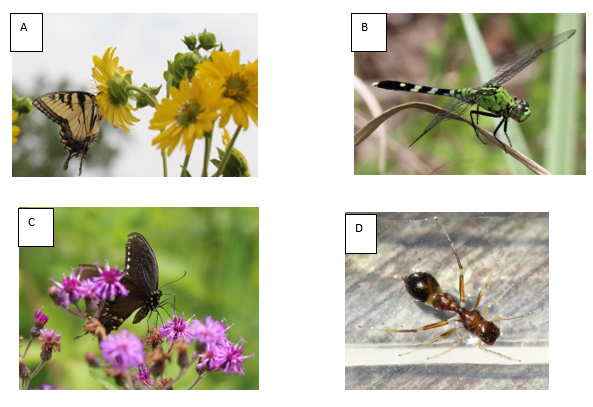 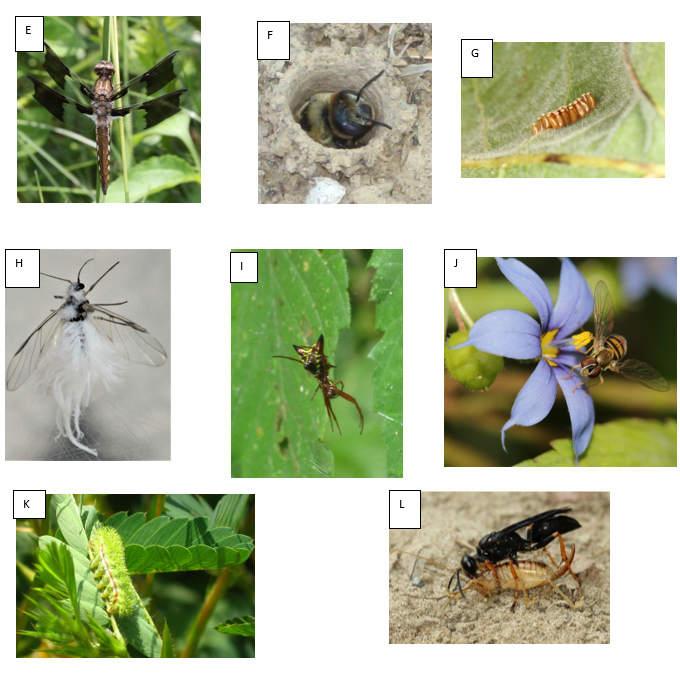
The Indiana Master Naturalist program is sponsored by the Resource Conservation & Development Councils, Indiana Soil & Water Conservation Districts, Purdue Cooperative Extension Service and Indiana Department of Natural Resources. www.indianamasternaturalist.org
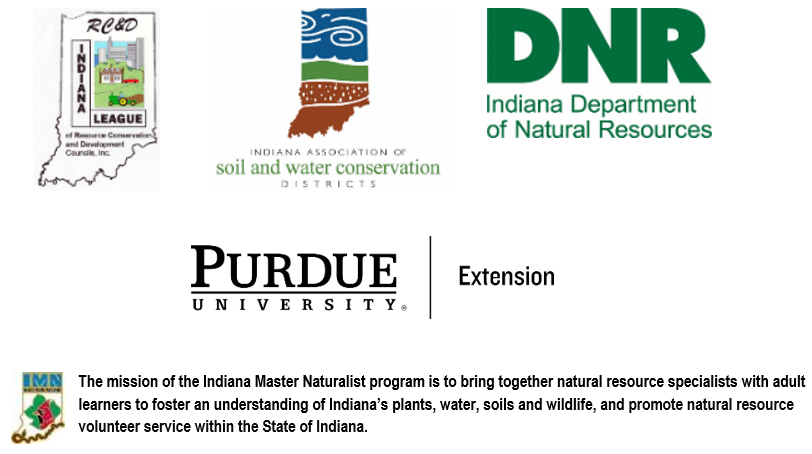
|